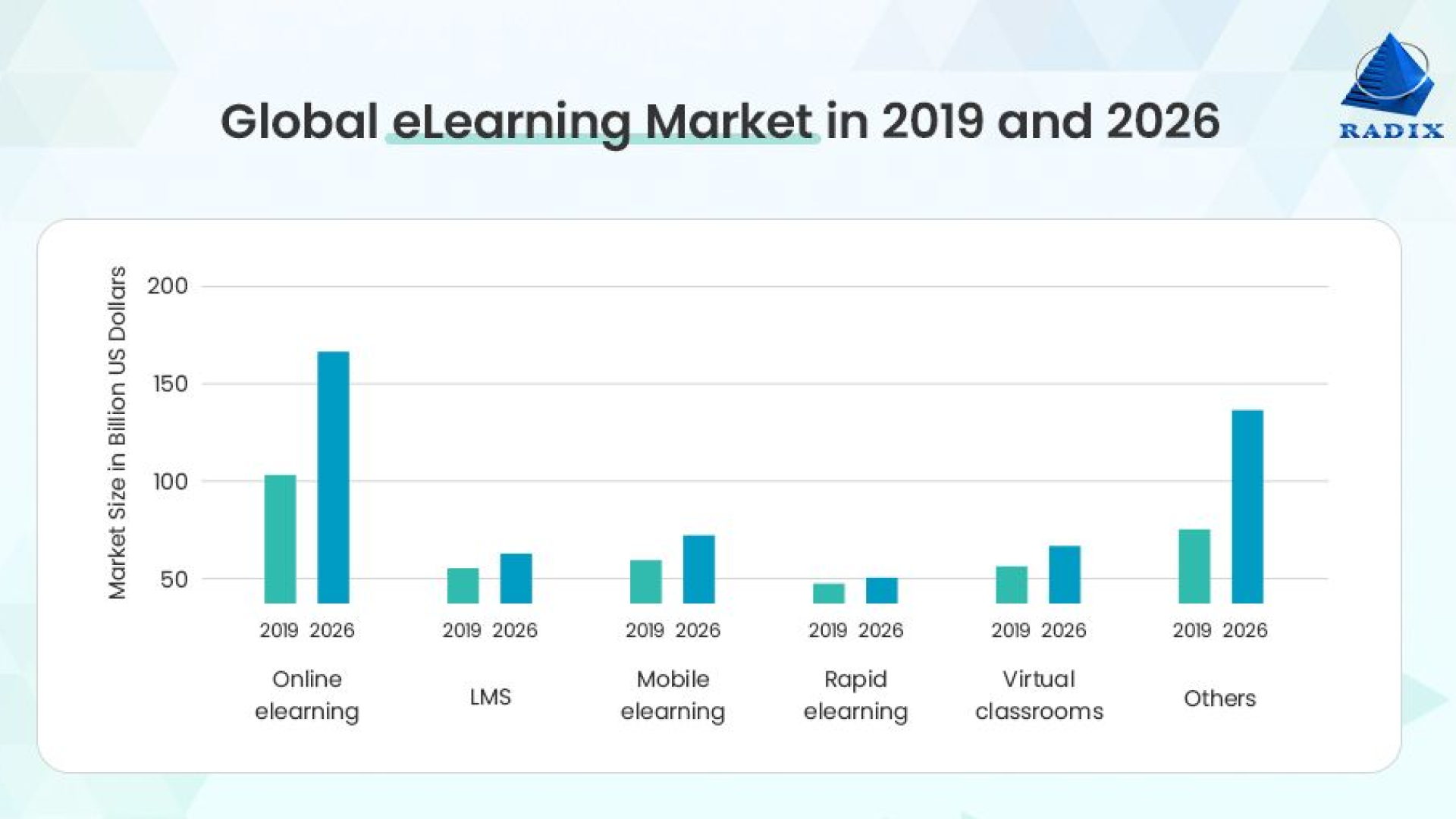The advent of digitization has firmly established E-learning as a cornerstone of modern education. Its popularity soared during the global pandemic, turning online classes and distance education into the new normal. Interestingly, E-learning has been around much longer than most people realize, dating back to 1999. As the E-learning market continues to grow, reaching a projected $325 billion by 2025, it’s an opportune time to explore the key technical aspects of developing a successful E-learning application.
Statistics Highlighting E-Learning Growth
- The global E-learning market was valued at $101 billion in 2019 and is projected to reach $370 billion by 2026, growing at a CAGR of 14.6% .
- Over 60% of internet users have engaged in some form of online learning, highlighting the widespread acceptance and popularity of E-learning.
- The corporate E-learning market is expected to grow by over 250% from 2017 to 2026.
The Appeal of E-Learning
E-learning is convenient and accessible. With just a smartphone and internet connection, you can start learning from anywhere, regardless of age or skill level. As the E-learning market continues to expand, businesses looking to develop their own E-learning applications need to consider several key technical aspects. Here is a comprehensive checklist to ensure your E-learning application is successful.
1. Learning Management System (LMS)
Importance of LMS
A Learning Management System (LMS) is the backbone of any E-learning application. It helps design and prepare courses that offer a seamless learning experience. An LMS should be customizable, allowing you to structure courses and modules according to your needs. Moreover, it should support course editing and revisions as you progress.
Before launching the platform, go through an LMS integration checklist to ensure the system connects with other tools and complete an LMS features checklist to verify all required features are included.
Security Considerations
Security is paramount. Ensure your LMS is robustly secured to prevent data breaches. This involves regular security updates and implementing strong authentication mechanisms.
2. Hosting Options
Hosted LMS vs. Cloud-Based Platform
When deciding where to host your E-learning application, you have two options: a hosted LMS or a cloud-based platform.
- Hosted LMS: This involves installing the LMS on your company’s server, storing all data in-house. While this option offers more control, it is time-consuming and requires thorough compatibility testing with your existing network and software architecture. Be sure to follow an LMS integration checklist to ensure smooth deployment. System integration can take 3 to 6 months, depending on the complexity.
- Cloud-Based Platform: Cloud-based platforms are gaining popularity due to their ease of setup and maintenance. They do not require installing software on individual devices and offer quick scalability. Using an LMS features checklist during setup ensures all key functionalities are covered. However, you must ensure that the service provider offers robust security measures to protect your data.
3. Integration with Other Systems
Comprehensive Integration
A successful E-learning application should integrate seamlessly with other systems like HR software, Business Intelligence (BI) systems, and Customer Relationship Management (CRM) systems. This ensures you cover all aspects of running an E-learning business, from tracking student progress to managing performance reviews for employees enrolled in courses.
Compatibility
Before integrating any software, ensure compatibility with your E-learning platform. This prevents disruptions and ensures a smooth user experience.
4. Video Asset Protection
DRM Techniques
Protecting your video content is crucial to prevent unauthorized downloads and viewing. Employ Digital Rights Management (DRM) techniques to encrypt your videos. This ensures only authorized users can decrypt and view the content, safeguarding your intellectual property.
5. Payment Processing
Smooth Checkout Experience
Payment processing is a critical component. Ensure that payment gateways are seamlessly integrated into your E-learning application to provide a hassle-free checkout experience. Smooth payment processing is key to maintaining high conversion rates and ensuring a steady revenue stream.
Benefits of E-Learning Platforms
E-learning platforms offer numerous advantages for both learners and educators. As technology continues to evolve, these platforms provide flexible, efficient, and cost-effective ways to deliver and receive education. Here are some key benefits:
1. Flexibility and Convenience
- Anytime, Anywhere Learning: Learners can access course materials and participate in classes at their convenience, fitting education around their schedules.
- Self-Paced Learning: Students can learn at their own pace, spending more time on challenging topics and moving quickly through areas they understand well.
2. Cost-Effective
- Reduced Costs: E-learning eliminates the need for physical infrastructure, reducing expenses related to classrooms, utilities, and maintenance.
- No Travel Expenses: Learners save on commuting costs, and institutions can reach a global audience without incurring travel expenses.
3. Wide Range of Courses
- Diverse Offerings: E-learning platforms offer a broad spectrum of courses, from academic subjects to professional development and topics of personal interest.
- Access to Expert Instructors: Learners can study with renowned instructors and experts from around the world.
4. Personalized Learning
Adaptive Learning: Platforms can tailor content and assessments based on individual learner progress and performance.
Custom Learning Paths: Learners can choose courses that align with their goals and interests, creating a personalized education experience.
5. Scalability
- Expand Reach: Institutions can scale their offerings to accommodate more learners without significant additional costs.
- Efficient Resource Use: Digital resources can be reused and updated easily, making it more efficient to manage and deliver content.
As technology continues to advance, the advantages of e-learning will only become more pronounced, solidifying its role as a vital component of modern education.
Top e learning platform features
Creating a successful E-learning platform involves integrating features that enhance the learning experience, streamline administration, and ensure the security and scalability of the system. Here are the top features that should be included in a robust E-learning platform:
User-Friendly Interface
A simple and intuitive interface ensures that learners can navigate the platform easily. Key elements include:
- Dashboard: Provides an overview of courses, progress, and notifications.
- Navigation: Easy access to courses, modules, and resources.
- Search Functionality: Allows users to quickly find content and courses.
Course Management
Efficient course management tools help instructors create, organize, and manage courses effectively.
- Course Creation Tools: Drag-and-drop functionality, templates, and multimedia support.
- Course Scheduling: Options for self-paced, instructor-led, or blended learning formats.
- Content Management: Upload and organize videos, documents, quizzes, and other resources.
Interactive Learning
Engagement is key to effective learning. Interactive features include:
- Quizzes and Assessments: Multiple-choice, true/false, and essay questions.
- Discussion Forums: Enable peer-to-peer interaction and instructor feedback.
- Live Classes and Webinars: Real-time interaction through video conferencing tools.
Personalization
Personalized learning paths improve learner engagement and outcomes.
- Adaptive Learning: Content and assessments that adapt to learner performance.
- Recommendations: Course suggestions based on past activity and interests.
- User Profiles: Track progress, achievements, and preferences.
Gamification
Gamification elements make learning more engaging and fun.
- Badges and Certificates: Rewards for course completion and milestones.
- Leaderboards: Foster competition and motivate learners.
- Points and Levels: Incentivize progress and participation.
Analytics and Reporting
Detailed analytics and reporting help track performance and make data-driven decisions.
- Learner Progress: Track completion rates, quiz scores, and engagement levels.
- Course Performance: Analyze which courses are the most popular and effective.
- Custom Reports: Generate reports based on specific metrics and timeframes.
Mobile Compatibility
Mobile learning is essential for accessibility and convenience.
- Responsive Design: Ensure the platform works well on all devices.
- Mobile App: Provide a dedicated app for offline access and push notifications.
Content Library
A comprehensive content library enhances learning resources.
- Resource Repository: Centralized storage for all learning materials.
- Content Curation: Easily curate and share relevant resources.
- Multi-Format Support: Accommodate various content formats, including video, audio, and text.
Collaboration Tools
Collaboration tools enhance learner interaction and teamwork.
- Group Projects: Facilitate group assignments and projects.
- Messaging: Enable direct communication between learners and instructors.
- File Sharing: Allow easy sharing of documents and resources.
Accessibility Features
Ensure the platform is accessible to all learners, including those with disabilities.
- Screen Reader Compatibility: Support for screen readers and other assistive technologies.
- Closed Captions: Provide captions for video content.
- Keyboard Navigation: Ensure all functionalities are accessible via keyboard.
E-Commerce Integration
For platforms offering paid courses, e-commerce features are essential.
- Payment Gateways: Integrate with payment processors like PayPal, Stripe, etc.
- Subscription Management: Handle subscriptions and recurring payments.
- Discount Codes and Promotions: Offer discounts and promotional codes to attract learners.
By incorporating these top features, an E-learning platform can offer a comprehensive, engaging, and secure learning experience. As the demand for online education continues to grow, staying updated with the latest trends and technologies will ensure that your platform remains competitive and effective in meeting the diverse needs of learners.
As the E-learning market continues to bloom, it is crucial for online learning solutions to evolve and efficiently cater to the needs of diverse demographics. By paying attention to key technical aspects such as LMS, hosting options, system integration, video asset protection, and payment processing, you can build a successful E-learning application that meets the growing demand for digital learning.











